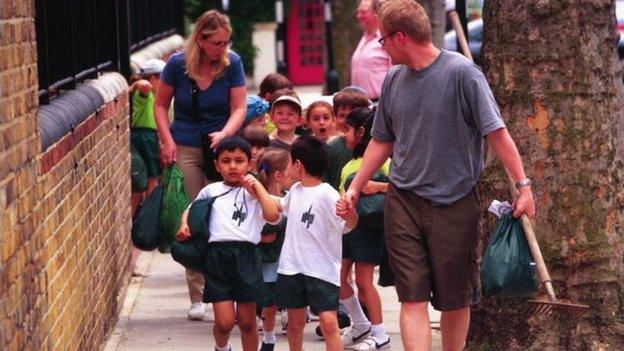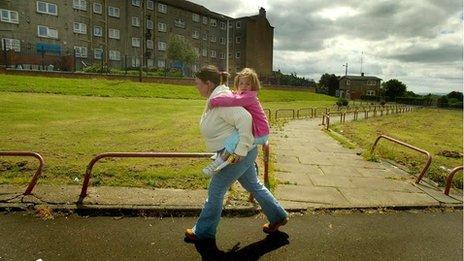Primary school places revealed amid squeeze
- Published
- comments

Some children will face longer walks to school than others
More than half a million families are discovering which primary schools their children will attend, amid a growing places squeeze in parts of England.
Early indications are of wide variations nationwide, with up to one in six missing out on their first choice of school in some areas.
While in other areas, almost all got their number one preference.
It comes days after council leaders said two in five local authorities would have too few places by 2016.
Pressure is growing, particularly in schools on London's fringes and in cities such as Leicester, Nottingham, Reading and Peterborough.
However, in London, around 99,000 pupils or 95% received a place at one of their six preferred schools this year - up 1,100 and nearly five percentage points from last year.
Of those, 81% got into their first preference school, the same proportion as the two previous years. But there were wide local variations within the capital. In Kensington and Chelsea, only 59% got their first preference, while in Barking and Dagenham it was 91%.
This comes against a backdrop of an extra 900 applications in the capital this year.
'Balkanised system'
The crisis has been precipitated mainly by a booming birth-rate, partly by immigration and by families moving specifically to be near popular schools.
The demand for school places has risen steeply in Harrow, which has some very good primary schools. It was predicted to be 12% over capacity by this September but the council said it had worked really hard to ensure there are enough places for Harrow children this year.
A spokesman said the crush Harrow was seeing now was very likely to affect other areas around the country soon.
Initial results from a Press Association survey of town halls shows families in some areas are more likely to gain a place at their top choice than in others.
Results from Birmingham show 84.7% of children starting reception have got a place at their first preference, while 94.8% got one of their listed choices. Around one in 20 applicants - 826 children - were given a school that was not one of their preferred options. A further 3.3% - 532 youngsters - have been offered a school outside the city.
Figures from East Sussex show 84.68% got their first choice, while in Southampton the percentage was 85.4%.
In Derbyshire, 93.4% of youngsters received their first pick, in Torbay it was 86.2%, Bristol was 84% - up from 82% last year, and in Cornwall it was 90.7%.
Surpluses
In Kent the figure was was 85.81%, up slightly from 84.9% last year.
Labour and the National Association of Head Teachers also blame the coalition government's free-school policy, which has allowed some new schools to be opened in areas that already have surplus places.
At the same time, the ability of local authorities to plan for population surges has been reduced by regulations requiring any new schools to be either an academy or a free school, rather than a council school.
NAHT general secretary Russell Hobby said: "We have a balkanised system with authorities, academies and central government taking decisions in isolation."
He added: "There is a desperate need for long-term planning that spans all sectors. With the massive increase in pupil numbers and over-stretched budgets, we cannot afford inefficiency and conflict."
The Local Government Association said the escalating places shortage was one of the key areas that needed to be tackled by the next government.
'Raise standards'
Earlier this month, it said schools were "reaching their limits and could soon run out of space and money for extra places" and there would be a need for an extra 880,000 pupils at a cost of £12bn.
The Conservatives blame Labour for the problem saying the party "cut over 200,000 primary school places - and even ignored official warnings to provide extra school places after a baby boom".
A spokesman added: "The Conservatives have created over 400,000 school places. There are fewer children in overcrowded primary schools and, most importantly, one million more children in good or outstanding schools since 2010."
Labour points out that under the Conservative-Lib Dem administration the number of infant children in classes with more than 30 pupils has more than trebled from 31,265 in 2010 to 102,615 in 2015.
Shadow education secretary Tristram Hunt blamed the Conservatives for spending "hundreds of millions of taxpayers' money on a few free schools in areas where there are no shortages of places".
But Natalie Evans, director of New Schools Network, said: "Over 90% of primary free schools opened or approved to open are in areas where new school places are needed. But they are also offering new choices in areas of low standards."
Liberal Democrat schools minister David Laws said: "It's astonishing that Labour and the Conservatives won't properly fund these children. It will be impossible to provide a place for every child and raise standards unless we protect education budgets."
Ty Goddard, co-founder of think-tank Education Foundation, said England's vast education property estate could be used with more imagination, but called for the parties to work together on solving the school places issue. He said a national "school places taskforce" should be set up to solve the issue with clarity, speed and partnership.
- Published16 April 2015
- Published3 April 2015

- Published23 July 2014
